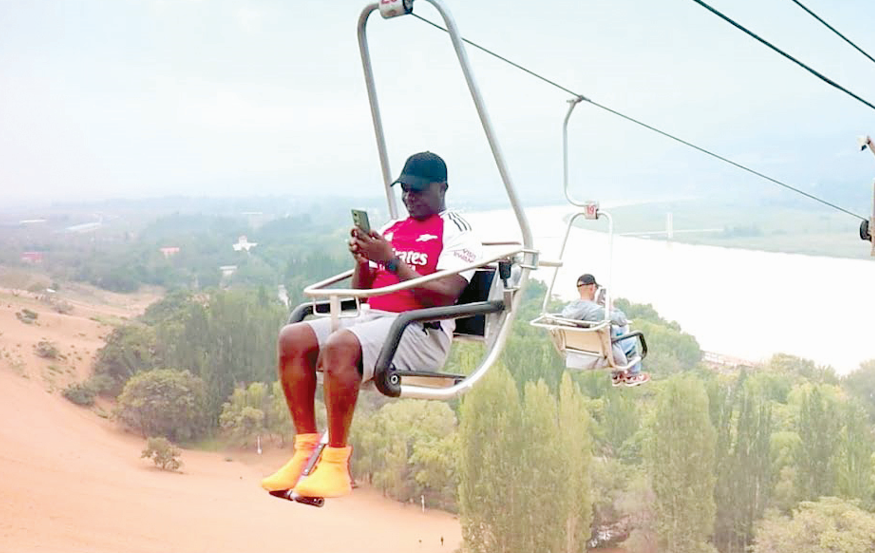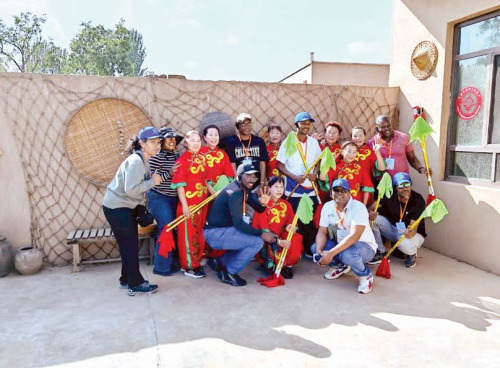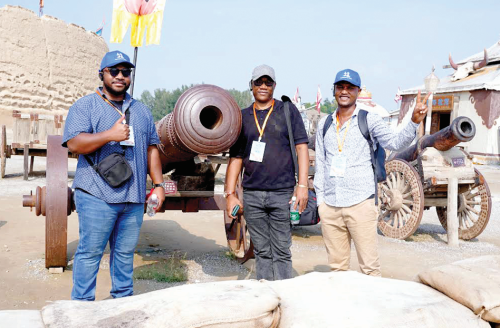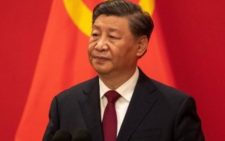Exploring the unexpected on a group tour of Ningxia, China

Travel constantly challenges us to adapt to and explore new surroundings and engage with different people to embrace adventures and share new and meaningful experiences with friends and loved ones.
This could have summarised the intention of Global Times News- China in partnership with Travelog to take some African Journalists on a visit of Ningxia Autonomous Region in North West China.
The morning weather was sunny illuminating the streets and skyscrapers of Beijing City when officials behind our trip read out the travel itinerary, as well as what weather conditions was likely to greet us.
Before the meeting, we had already arranged for lunch with Mr Li Changdong- a Chinese investor, business mogul and socialist per excellence. He had wanted to meet the African journalists, a request we granted.
We set out for the journey very early on a Wednesday morning. The trip coincided with the end of the Mid-Autumn festival, also know as the moon festival, a harvest festival celebrated in Chinese culture. We met a swam of passengers on the move to catch their flights.
Crew of journalists
We had arrived some minutes past 7am, quite early for our flight, which had been scheduled for 9am.
My colleagues, Ghana’s Samuel Ayama, his compatriot Raphael Oni of Nigeria nicknamed ‘Oga’, Zimbabwean self-styled vegetarian Jonathan Marerwa and his partner in ‘crime’ soft -spoken Khadar from Somalia, Tanzania’s Kanky, Lesotho’s Motheba, Gambia’s maverick Jainaba, South Africa’s International brand’s maestro Ayanda, Ethiopia’s scribe Afework his lieutenant and Eritrean staunch Muslim Suleiman and myself were expectant albeit with mixed feelings.
Global Times crew led by Cathy Wang Yutian, Shi Jierui baptised ‘Jerry’, Li Yao and the soprano voice Liu Jian were thrilled to be part of the history in the making.

Jonathan led the group in taking a vantage position perhaps as a reminder of his maiden visit to the region.
The time came to board the flight and as a ritual we had to go through the security checks. Used to the security checks in Kenya, I was astonished by the rigorous nature of the security process at Beijing Capital International Airport Terminal 2.
It was after two hours that the plane landed at the Yinchuan Hedong International Airport, the capital city of Ningixia autonomous region.
When we arrived, some three buses were on standby to take us to a sumptuous lunch just near the Zhenbeibu Western Film studio Museum. The Global Times crew and the 11 African journalists boarded a blue long executive blue bus while the other officials boarded some two Coaste luxurious buses.
It appeared to me that we were not only esteemed visitors, but our visit was of utmost importance. Inside the bus, a young native of Yinchuan and an Inner Mongolia based historian Lv Fengyan was doing her best telling us what to expect and the places to visit.
Outside, the temperature was welcoming as thin air made its way through our nostrils.
Our first stop was at a local restaurant for lunch, and instantly, we had become a tourist attraction-thanks to our skin colour. It appeared that in this part of the world, Africans were a rare species.
It was here that we found out that lamb was a delicacy. The Ningxian chefs had perfected the art of lamb preparation albeit in different styles.

The women and men both old and young could be seen staring at us and although language barrier had its field day, those among us who managed to utter some Chinese words became an instant sensation.
Inside the Zhenbeibu Western Film studios, the journalists walked from one location to another learning the pieces of collections and how the film making studio had become a household name.
Zhenbeibu Western Film Studio, located in Yinchuan, Ningxia Hui Autonomous Region, is a national 5A tourist attraction that offers sightseeing, entertainment, leisure, dining, and shopping.
Founded by writer Zhang Xianliang on September 21, 1993, the studio is known for its ancient, rustic, and rugged atmosphere, featuring major attractions, such as Ming City, Qing City, and Old Yinchuan Street, among other film shooting sites.
Virtual reality theatre
Apart from film making locations, some of the journalists engaged in relaxing activities— a stark reminder of their younger days at the virtual reality theatre and most importantly the Chinese traditional brew –‘Baichu’ made from sorghum.
In the scotching sun, Ayanda and I decided to taste the homemade traditional brew. The gulp on our faces depicted someone who had either chewed pepper or had bitten a raw unripe lemon. Our face automatically turned ugly, thanks to the 52 per cent alcoholic content and revered Chinese ‘wine’ as they call it here.
Later in the evening, we passed by an open market. Here we found Chinese Muslim community. Food vendors were busy selling their delicacies from pork, lamb, chicken, vegetables and fruits.
The following morning, we set out to visit KOCEL Company limited. The firm produces various machines and car parts used globally. And although we had many questions than answers, time was limited.
The same day in the evening, we visited Ningxia Museum, where there was much to see and learn, however, a majority of us were already exhausted and time was limited. I had to confront Ms Wang and registered my frustrations.
“Why are you always in a hurry? As journalists we need time to figure out our story, put our thoughts together before deciding who we should interview. We feel that we are being rushed,” I exclaimed.
Ningxia Museum houses nearly 40,000 cultural relics, including 159 national first-grade cultural relics, and over 4,000 precious cultural artifacts above the third grade.
The following day, we left for Zhongwei City in the western part of Ningxia Hui Autonomous Region. The city borders Gansu to the west and Inner Mongolia to the north and has been a strategic trading centre for thousands of years.
It was a chilly morning as we toured the ancient Yellow River Irrigation System of Ningxia. Armed with interpretative devices, hoods and umbrellas to shield ourselves from the unforgiving weather, the quest for information about the hydro-power along the Yellow river was palpable.
The enormous Yellow River enters Ningxia from Southchangtan, Zhongwei City, flows through Qingtongxia, and exits at Mahuanggou, Shizuishan City, a total distance of 397 kilometres. Among the nine provinces along the Yellow River, Ningxia is the only one whose entire territory lies within the Yellow River basin, making it the beneficiary of the Yellow River diversion irrigation.
After spending the night at a hotel in Zhongwei City, we left for the Xizan Goji berry plantation about one hour 30 minutes drive. Here, the journalists swarmed into the tiny red berries, you would think they had been starving for days, thanks to the rare Goji berries.
Traditional dancers
Here it was race against who would fill their small containers with the red berries. Unknown to us, we would later be shown the value addition processing plant that makes Goji berries juices.
Later in the afternoon, after a sumptuous meal, we visited the Huangyang Ancient village. Here, we found traditional dancers making a jig. We joined in the dance and although our moves and theirs were at constant cross roads, the confusion created a rib cracking scenario.
On the eve of our departure back to Beijing, the organisers took the crew to experience the Flying Apsaras in the desert. Camel riding, sheepskin rafting and the desert ‘safari’ crowned it all.
Ningxia autonomous region— the home to Yinchuan and Zhongwei left a mark of a quality visit. Given another chance, I would love to visit the region again and again.














